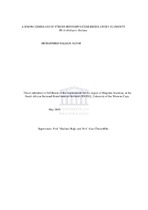| dc.description.abstract | Stress responsive genes play a key role in shaping the manner in which plants process and respond to environmental stress. Their gene products are linked to DNA transcription and its consequent translation into a response product. However, whilst these genes play a significant role in manufacturing responses to stressful stimuli, transcription factors coordinate access to these genes, specifically by accessing a gene's promoter region which houses transcription factor binding sites. Here transcriptional elements play a key role in mediating responses to environmental stress where each transcription factor binding site may constitute a potential response to a stress signal. Arabidopsis thaliana, a model organism, can be used to identify the mechanism of how transcription factors shape a plant's survival in a stressful environment. Whilst there are numerous plant stress research groups, globally there is a shortage of publicly available stress responsive gene databases. In addition a number of previous databases such as the Generation Challenge Programme's comparative plant stressresponsive gene catalogue, Stresslink and DRASTIC have become defunct whilst others have stagnated. There is currently a single Arabidopsis thaliana stress response database called STIFDB which was launched in 2008 and only covers abiotic stresses as handled by major abiotic stress responsive transcription factor families. Its data was sourced from microarray expression databases, contains numerous omissions as well as numerous erroneous entries and has not been updated since its inception.The Dragon Arabidopsis Stress Transcription Factor database (DASTF) was developed in response to the current lack of stress response gene resources. A total of 2333 entries were downloaded from SWISSPROT, manually curated and imported into DASTF. The entries represent 424 transcription factor families. Each entry has a corresponding SWISSPROT, ENTREZ GENBANK and TAIR accession number. The 5' untranslated regions (UTR) of 417 families were scanned against TRANSFAC's binding site catalogue to identify binding sites. The relational database consists of two tables, namely a transcription factor table and a transcription factor family table called DASTF_TF and TF_Family respectively. Using a two-tier client-server architecture, a webserver was built with PHP, APACHE and MYSQL and the data was loaded into these tables with a PYTHON script. The DASTF database contains 60 entries which correspond to biotic stress and 167 correspond to abiotic stress while 2106 respond to biotic and/or abiotic stress. Users can search the database using text, family, chromosome and stress type search options. Online tools have been integrated into the DASTF, database, such as HMMER, CLUSTALW, BLAST and HYDROCALCULATOR. User's can upload sequences to identify which transcription factor family their sequences belong to by using HMMER. The website can be accessed at http://apps.sanbi.ac.za/dastf/ and two updates per year are envisaged. | en_US |

